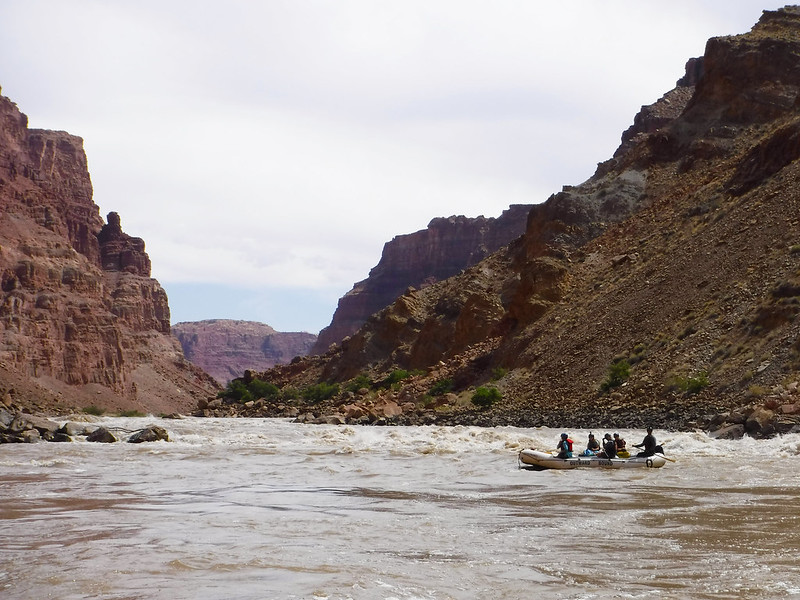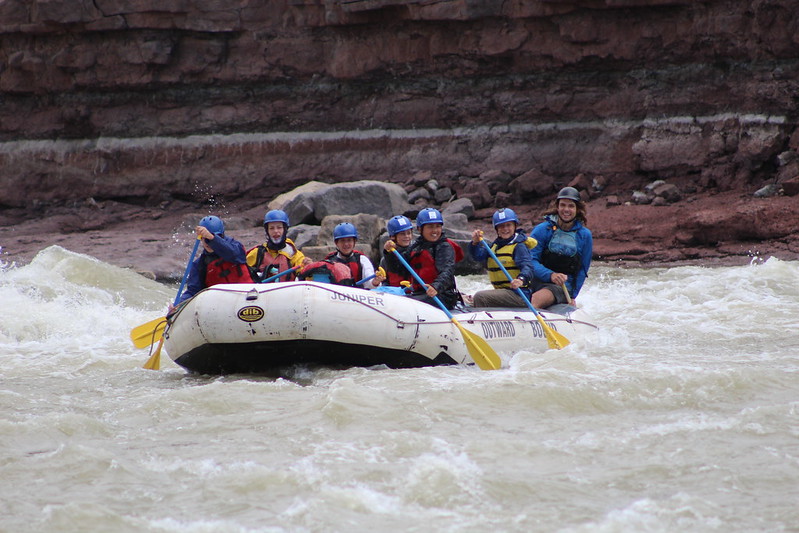Cataract Canyon, Utah
You hear “ALL FORWARD!” shouted above the roar of the rapids by the captain of your raft (that could be you). Next thing you know, you’re digging your paddle blade in deep to meet some of the biggest and best whitewater of the West. One of the most rugged and beautiful canyons in the West, Cataract Canyon takes you through the heart of Canyonlands National Park. You will learn how to guide a whitewater raft as you float past natural wonders and ancient dwellings to the confluence of the Colorado and Green Rivers while preparing for what awaits downstream. The Colorado River roars through 29 exciting rapids that rate with those of the Grand Canyon in power and difficulty, including the famous Mile Long Rapids and “the Big Drops.” In the nearby canyons, fantastic rock shapes carved by the whimsical forces of nature await you as your group ventures off-river to jaw-dropping views. This region is located within the ancestral lands of the Ute nation.

Photo: Olivia Schneider |📍Ute lands
What is a land acknowledgment?
At the Colorado Outward Bound School, we include land acknowledgments in our work as a formal way to recognize and respect the traditional territories and Indigenous Peoples as stewards of the land. It is important to understand and acknowledge the comprehensive past, present, and future of the places we travel and to seek to understand our role therein. To recognize the land is an expression of gratitude and appreciation we give to the Indigenous Peoples who have been living and working on the land from time immemorial. Read more about land acknowledgments at Outward Bound here.
Rafting
On the river, each day is spent learning to navigate various obstacles and how to anticipate the forces of the current from upstream. You and your companions will work to become a team, coordinating your spacing and paddle strokes. You will have an opportunity to be the captain of your crew and put to use what you’ve learned as you maneuver your raft through Class 2-4 rapids. Interspersed between the rapids are flat-water sections where there is a current, but no whitewater. At times, you will take advantage of this calm water to hone your skills and enjoy the view. Time in a raft is ideal for getting to know each other and forming boat pride, laughing your way downriver as you relax into river life. Afternoons can bring strong up-canyon winds, which create a challenge as you dig in to reach the camping destination. Rafting connects you to the river: the oasis of flora and fauna (including humans!) that rely on the river to survive in the desert. The soaring canyons complement the roar of whitewater, as well as the silences that can only be found in such remote beauty.

Photo: Curtis Huey |📍Núu-agha-tʉvʉ-pʉ̱ (Ute), Diné, and Pueblos lands
Solo
Solo is a time when you’ll get the opportunity to spend time alone during course. With sufficient food and equipment, your Solo will be a chance to reflect on your course experience, journal, and connect with nature. Depending on your course length and environmental factors, Solo can range from 30 minutes to an overnight experience. You will not travel during this time and your Instructors may check on you occasionally. Your solo site will be close enough to your Instructors in case of emergency, but far enough removed to enjoy solitude. Many students are initially nervous about solo, but later recall it as one of the highlights of their course.
Service
Service is a pillar of the Outward Bound experience. On each course, students learn to practice intentional service to themselves, to others and to the environment. This may look like practicing self-care or supporting a crewmate who is having a hard day. Participants also learn to Leave No Trace ethics, practicing service to the environment by preserving and respecting the fragile ecosystems they encounter. Students experience firsthand the social and emotional benefits of acts of service. They are encouraged to bring this ethic of care to their life back home.
The following is an example of what your itinerary may look like. Your actual course plan will vary according to weather, your group’s skills and abilities, and Instructor preferences.
Day 2-7: River Launch, Whitewater Rafting, Day Hikes, Solo, Possible Service project
Day 8: Course End and Transportation Home
Our expeditions help students grow into the best version of themselves. We use adventure in the outdoors to help students discover their strengths and build authentic connections with their peers. Compassion for oneself and others is foundational to the Outward Bound experience. As students develop outdoor skills, they also gain confidence and leadership tools that will last a lifetime. Course outcomes include:
- Belonging – students form deep connections founded upon respect, inclusion, and compassion
- Reflection – students learn self-awareness and practice empathy towards others
- Physical Engagement – students develop awareness and confidence in their bodies
- Courage – students develop the confidence to speak up for themselves and persevere through challenges
Watch to Learn More
Tuition
You can pay your tuition online through your Applicant Portal or make the payment over the phone by calling 720-381-6589.
If your payment is not received by the due date listed in your Enrollment Email and on your Applicant Portal, you will risk losing your spot on course and your $500 deposit. Please review our Admissions and Cancellation Policies.
Travel Insurance
Airfare, travel costs, and non-refundable tuition payments are expensive. Insurance to protect your trip and course is strongly encouraged. We recommend insuring these costs from the third-party provider InsureMyTrip. This provider has coverage options that include travel costs and non-refundable tuition costs. For more information and to receive a free quote, click here.
Click here for COBS COVID-19 Program Practices